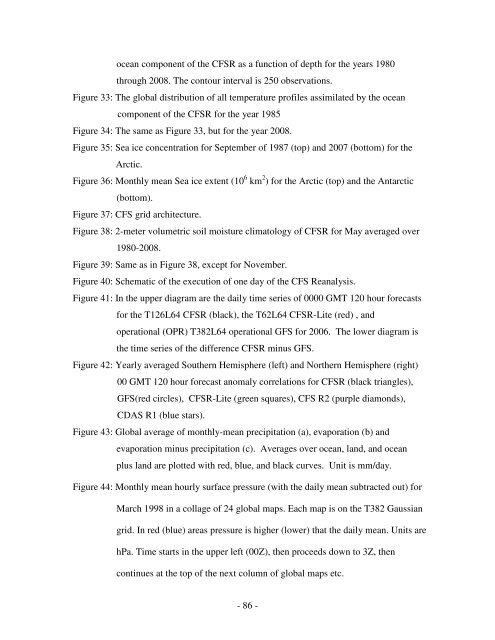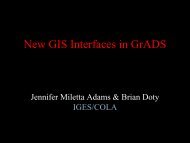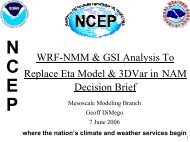The NCEP Climate Forecast System Reanalysis - NOAA National ...
The NCEP Climate Forecast System Reanalysis - NOAA National ...
The NCEP Climate Forecast System Reanalysis - NOAA National ...
You also want an ePaper? Increase the reach of your titles
YUMPU automatically turns print PDFs into web optimized ePapers that Google loves.
ocean component of the CFSR as a function of depth for the years 1980through 2008. <strong>The</strong> contour interval is 250 observations.Figure 33: <strong>The</strong> global distribution of all temperature profiles assimilated by the oceancomponent of the CFSR for the year 1985Figure 34: <strong>The</strong> same as Figure 33, but for the year 2008.Figure 35: Sea ice concentration for September of 1987 (top) and 2007 (bottom) for theArctic.Figure 36: Monthly mean Sea ice extent (10 6 km 2 ) for the Arctic (top) and the Antarctic(bottom).Figure 37: CFS grid architecture.Figure 38: 2-meter volumetric soil moisture climatology of CFSR for May averaged over1980-2008.Figure 39: Same as in Figure 38, except for November.Figure 40: Schematic of the execution of one day of the CFS <strong>Reanalysis</strong>.Figure 41: In the upper diagram are the daily time series of 0000 GMT 120 hour forecastsfor the T126L64 CFSR (black), the T62L64 CFSR-Lite (red) , andoperational (OPR) T382L64 operational GFS for 2006. <strong>The</strong> lower diagram isthe time series of the difference CFSR minus GFS.Figure 42: Yearly averaged Southern Hemisphere (left) and Northern Hemisphere (right)00 GMT 120 hour forecast anomaly correlations for CFSR (black triangles),GFS(red circles), CFSR-Lite (green squares), CFS R2 (purple diamonds),CDAS R1 (blue stars).Figure 43: Global average of monthly-mean precipitation (a), evaporation (b) andevaporation minus precipitation (c). Averages over ocean, land, and oceanplus land are plotted with red, blue, and black curves. Unit is mm/day.Figure 44: Monthly mean hourly surface pressure (with the daily mean subtracted out) forMarch 1998 in a collage of 24 global maps. Each map is on the T382 Gaussiangrid. In red (blue) areas pressure is higher (lower) that the daily mean. Units arehPa. Time starts in the upper left (00Z), then proceeds down to 3Z, thencontinues at the top of the next column of global maps etc.- 86 -





